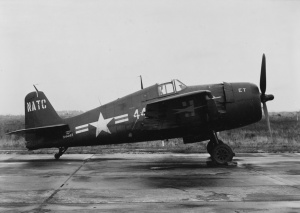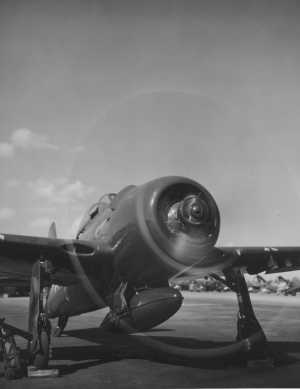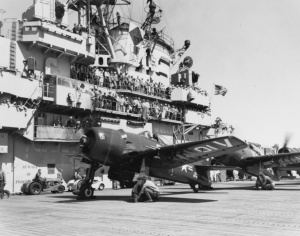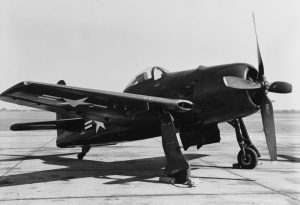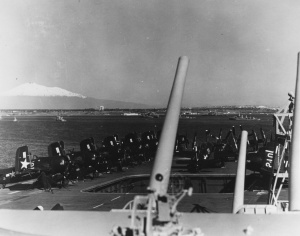F8F Bearcat (Family)
Contents
Vehicles
Rank III
Rank IV
Development and Design
Development
The concept of the G-58 (the Grumman designation for what would become the F8F Bearcat) began on 23 June, 1942. The Vice President of Grumman Aircraft Engineering Corporation Jake Swirbul met with F4F Wildcat pilots that had fought in the Battle of Midway. Jimmie Thatch - one of the pilots - emphasized the fact that climb rate is one of the most important characteristics of a good plane.Climb rate is linked to power-to-weight ratio, so to increase climb rate a powerful engine and small, lightweight airframe are necessary. Not only would the G-58 have to have a good climb rate, but it also needed to be able to operate from escort carriers, which the F6F Hellcat was too large to operate from, and as such only the obsolete F4F Wildcat could operate from the escort carriers. A small, light aircraft could accomplish both goals; it could operate from the escort carriers and it could have a good climb rate. Grumman began developing the G-58 Bearcat in late 1943, after studying carrier warfare in the Pacific for a year and a half.
It is thought by some that the FW-190 influenced the design of the G-58, but it has never been confirmed, and it's still up for debate. The Grumman test pilots flew and examined a captured FW-190 in 1943 in England, and the G-58 also has a number of features very similar to the FW-190 such as the landing gear and cowling arrangements, but there is no hard evidence that the data from the testing of the FW-190 was used to develop the G-58.
Design
Powerplant
The Grumman F6F Hellcat was introduced in 1943, and it was based on the Pratt & Whitney R-2800 engine, producing 2,000 horsepower. The R-2800 was the most powerful American engine available then, and so the R-2800 would also be used on the G-58 Bearcat. This meant that improved performance over the F6F Hellcat would mean a lighter and smaller airframe.
Airframe
The fuselage of the Bearcat was 5 feet (1.5 meters) shorter than the Hellcat, and the area behind the cockpit was reduced vertically. As such, a bubble canopy could be fitted, and the Bearcat was the first US Navy fighter to have one. The vertical stabilizer used was the exact same as on the Hellcat, but it looked thinner because of an increased aspect ratio. The Bearcat had a 7 foot shorter wingspan than the Hellcat. The fuselage used flush riveting and spot welding to maintain structural integrity, and was made with a heavy gauge 302W aluminum alloy skin in order to allow for rough carrier landings. Armor was used to protect the pilot, engine, and oil cooler.
Propeller and Landing Gear
The propeller used on the F6F Hellcat was a 13 ft 1 in Hamilton Standard 3-bladed propeller, but in order to reduce the size of the propeller a 12 ft 7 in Aeroproducts 4-bladed propeller was used on the Bearcat. In order to keep the propeller from hitting the deck of the aircraft carrier the Bearcat used long landing gear; the Bearcat had a distinct nose-up profile when on land. The undercarriage was hydraulically operated, and it used an articulated trunnion to extend the oleo struts when the landing gear was lowered. When the landing gear were raised the oleo struts were shortened, and they retracted into fully enclosed wheel wells in the wings. The wide landing gear arrangement gave the Bearcat great handling characteristics on the ground and carrier deck.
Weight Reduction Efforts
A goal of a fully loaded weight of 8,750 lb/3,969 kg for the G-58 was set by the design team, but it became clear that the weight goal was impossible as the Bearcat had to be able to sustain rough carrier landings. In order to reduce the weight as much as possible, the internal fuel capacity to 160 gal (606 l); this was later increased to 183 gal. The fixed armament was also limited to four .50 cal M2/AN Browning machine guns, with two in each wing. Because of the reduced fuel load, the Bearcat would be useful as an interceptor, but not for long range patrols; the F6F Hellcat would have to be retained for that role. Later on, the role of defending the fleet from kamikaze attacks was added. The Bearcat was 20% lighter , had a 30% better climb rate, and was 50 mph (80 km/h) faster than the F6F Hellcat.
In order to reduce the weight further, the designers came up with detachable wingtips. Just like other carrier-based fighters, the wings could fold at about 2/3 out to reduce the space it would take up on the carrier. On other fighters the outer, folding portion of the wing was built just as strong as the rest of the wing, but on the Bearcat the outer wing was made to be much lighter, reducing weight. But, this meant that the outer wing would break off if the G force surpassed 7.5 G, as it was designed to. When this occurred, the plane would still be able to fly back to the carrier for repair, and the detachable wingtips saved 230 pounds (100 kg) of weight.
Prototypes
First Prototype
Grumman finished the design in November of 1943, and 2 prototypes were ordered on 27 November 1943 with the BuAir designation XF8F-1. The first flight of the XF8F-1 was on 21 August, 1944; it flew only nine months after the design process had started. Testing showed that the first prototype had a 4,800 feet (1,500 m) per minute rate of climb and a top speed of 424 mph (682 km/h). It was slightly slower than the Vought F4U Corsair, but it had a better climb rate and was more maneuverable.During the initial testing, a number of problems were discovered. It was horizontally unstable, the trim system was underpowered, the landing gear could only be extended at slow speeds, the airspeed indicator was inaccurate, and the cockpit was cramped.
Second Prototype
The test pilots requested that six machine guns be installed rather than four, but the number of machine guns was kept at 4 to keep the weight down. In order to increase stability, a triangular fillet was added to the front of the vertical stabilizer.
Production
On 6 October, 1944 the Navy ordered 2,023 F8F-1 Bearcat fighters, which were based on the second prototype. On 5 February, 1945 the Navy ordered 1,876 aircraft that were to be produced by General Motors and given the designation F3M-1; the F3M-1 was slightly modified, and it notably had a slightly larger fuel capacity. Grumman began deliveries on 21 May, 1945, but with the end of the war the Grumman order was reduced to 770 aircraft; the General Motors order was cancelled before any aircraft could be delivered.
The Navy placed another order for 126 aircraft, of the F8F-1B variant. The F8F-1B featured 4 x 20 mm M2 cannons replacing the four .50 cal machine guns. Fifteen of the F8F-1B aircraft were later upgraded into the F8F-1N night fighter variant, which had an APS-19 search radar mounted in the starboard wing.
An unmodified F8F-1 set the time-to-climb record (after a run of 115 ft/35 m) of 10,000 ft (3,048 m) in 94 seconds (6,383 fpm) in 1946. The record only broken 10 years later by a jet plane, but the jet had a longer takeoff run than the Bearcat.
An improved version of the Bearcat debuted in 1948, known as the F8F-2. It featured a revised engine cowling, a taller vertical fin, and a more powerful Pratt & Whitney R-2800-30W (2,240 hp) engine. 293 F8F-2 Bearcats were built, 12 F8F-2N night fighters were built, and 60 F8F-2P photo-reconnaissance variants were built.
Production of the Bearcat ended in 1949, and the Bearcat had begun to be phased out of service in the same year. The Bearcat was fully retired from service in 1952.
Service
American Service
The F8F Bearcat was first delivered in February of 1945, and Fighter Squadron 19 (VF-19) was operational by 21 May, 1945; it was the first squadron to be equipped with the Bearcat. The Bearcat never saw combat in World War 2, as the war ended before it had the chance.It quickly became apparent that the snap-off wings did not work as planned. During testing they worked fine, but in the strenuous conditions of operational service with the carrier fleet it was found that one wingtip would often break off instead of both, which could possibly cause the aircraft to crash. This issue was fixed when an explosive system was added, that would blow the wingtips off together instead of separately. The new system worked well, but it once caused the death of a technician when they were accidentally triggered. The wings were eventually reinforced and the aircraft was limited to 7.5 G.After the end of World War 2, the F8F Bearcat became the mainstay fighter aircraft for the Navy and Marine Corps, equipping a total of 24 Navy squadrons and several Marine Corps squadrons. The performance of the Bearcat was greater than that of many early jets, and it could outperform most other propeller-driven fighters of its day. In 1946 it was chosen as the second aircraft to be used by the Blue Angels flight demonstration squadron; it replaced the F6F Hellcat in the Blue Angels. The Blue Angels flew the Bearcat until 1950, when the squadron was called to combat service in the Korean War. In service, the F8F Bearcat was replaced by the F2H Banshee and F9F Panther/Cougar which had a higher performance than any propeller-driven aircraft of the time.
First Indochina War
The First Indochina War of 1946-1954 was the conflict which would first test the Bearcat in combat. In 1951, 200 Bearcats were delivered to France, and in 1954 (when the war ended) 28 of the Bearcats were given to the Republic of Vietnam Air Force - they entered service in 1956. The Vietnamese Bearcats were retired in 1960; they were replaced with Douglas A-1 Skyraiders and North American T28 Trojans as the Vietnam War (1957-1975) continued. At the same time, F8F Bearcats were being delivered to the Royal Thai Air Force.
Air Racing
Bearcats have been popular racing planes since civilians could first acquire them. In 1964, the first Reno Air Race was won by a stock Bearcat flown by Mira Slovak and sponsored by Bill Stead. The most notable Bearcat used in racing is known by the name Rare Bear, which was owned by Lyle Shelton and dominated the races for decades. Rare Bare set a number of records, notably the 3 km World Speed Record for piston-engine aircraft (528.33 mph/850.26 km/h) in 1989, and the time-to-climb record (3,000 m in 91.9 seconds (6,425.9 fpm) in 1972. Rare Bare often competed against Conquest 1, another Bearcat flown by Daryl Greenamyer. Conquest 1 was a holder of a world speed record for a time, and it is now on display at the Smithsonian's National Air and Space Museum in Washington D.C.
Variants
G-58: The Grumman Aircraft Engineering Corporation designation.
G-58A: A civilian model owned by the Gulf Oil Company for the use of Major Alford Williams.
G-58B: Civil model used by Grumman as a demonstration aircraft, piloted by Roger Wolfe Kahn.
XF8F-1: The two prototypes for the F8F-1 Bearcat.F8F-1: The first production model, based on the XF8F-1. It had a Pratt & Whitney R-2800-34W (2,100 hp), folding wings, self-sealing fuel tanks, 4 x 12.7 mm machine guns, and a retractable tail wheel.
F8F-1B: F8F-1 but with 4 x 20 mm cannons replacing the machine guns; 100 produced.
F8F-1D: F8F-1 aircraft converted to drone control aircraft.
F8F-1(D): Unofficial export designation for France and Thailand.
F8F-1E: Night fighter variant equipped with APS-4 search radar.
XF8F-1N: 2 prototype F8F-1 conversions to a night fighter, equipped with APS-19 radar.
F8F-1N: Night fighter production model, equipped with APS-19 search radar; 36 produced.
F8F-1P: F8F-1 conversions to a photo-reconnaissance variant.
F3M-1 or F8M-1: Planned designation of F8F-1s produced by General Motors.
XF8F-2: Two prototypes for the F8F-2, featuring an improved engine, revised cowling, and improved tail.
F8F-2: The second major production model, featuring an R-2800-30W engine, a revised engine cowling, an enlarged rudder and stabilizer, and it was armed with 4 x 20 mm cannons; 239 were produced.
F8F-2D: F8F-2s converted to drone control aircraft.
F8F-2N: Night fighter variant of the F8F-2, with APS-19 radar; 12 produced.
F8F-2P: Photo-reconnaissance variant of the F8F-2, armed with only 2 x 20 mm cannons; 30 produced.
Operators
- France
- French Air Force - Armée de L'air
- Thailand
- Royal Thai Air Force (RTAF)
- United States
- United States Navy (USN)
- United States Marine Corps (USMC)
- South Vietnam
- Republic of Vietnam Air Force (RVNAF)


